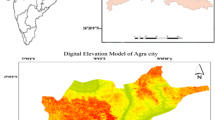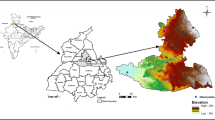Abstract
Groundwater is the primary source of fresh water in the world, including areas with high rainfall and large amount of surface water. Groundwater is the primary source of water supply and an important component of the water cycle as it maintains the flow of rivers during periods of low rainfall. Groundwater levels have fallen sharply due to the increased reliance on groundwater in recent years. Therefore, in order to understand the level of groundwater use and analyse the groundwater scenario such as recharge, discharge etc. in the study area, analysis of groundwater trends is essential. In this study the Mann–Kendall t-test was used to analyze the data collected from the eight hydrological stations located in Bina and Khurai blocks in Sagar district. The monthly GWL data of fifteen observation wells in which twelve wells are dug well and three wells are Piezometric wells of Bina and Khurai blocks for the period 2000–2016 have been used for the study. The minimum and maximum GWL was found to be 0.10 m (bgl) which is 420.6 m above mean sea level (msl) and 27.60 m bgl (429.50 m amsl) respectively. Contour map shows that average GWL vary between 4.07 m and 18.75 m bgl (i.e., 401.18 m to 438.35 m (amsl)) during pre-monsoon and 0.51 m to 16.18 m bgl (i.e., 404.71 m to 440.92 m above msl) during post-monsoon. This analysis investigated the pattern and trends of the daily groundwater level data using Mann–Kendall t-test as means of non-parametric test and parametric Sen’s Slope test on seasonal basis. Pre-monsoon and Post monsoon variations in groundwater trend of Bina and Khurai blocks of Sagar district for 16 years (2000–2016) were analysed using statistical non-parametric tests-the Mann–Kendall (MK) test and Sen’s slope estimator. The Mann–Kendall test indicated falling trends at most wells and rising trends at some wells and at few wells there were no significant trends. Mann–Kendall test showed falling trend was observed in most wells during pre-monsoon and post-monsoon in both blocks signifying overexploitation of groundwater whereas no trend was observed in few wells. Sen’s Slope test was used to identify the significance of the slope and it was seen that declining trend was observed at 95% confidence interval. An average temporal variation of groundwater shows declining trend in Bina and Khurai blocks.
Access this chapter
Tax calculation will be finalised at checkout
Purchases are for personal use only
Similar content being viewed by others
References
Gilbert RO (1987) Statistical methods of environmental pollution monitoring. Van Nostrand Reinhold, New York
Gocic M, Trajkovic S (2012) Analysis of changes in meteorological variables using Mann-Kendall and Sen’s slope estimator statistical tests in Serbia. Glob Planet Change 100:172–182
Kendall MG (1975) Rank correlation methods, 4th edn. Charles Griffin, London, UK
Kumar P, Chandniha SK, Lohani AK, Nema AK (2018) Trend analysis of groundwater level using non-parametric tests in alluvial aquifers of Uttar Pradesh, India. Curr World Environ 13(1):44–54
Mann HB (1945) Non-parametric test against trend. Econometrica 13:245–259
Mondal K, Mukhopadhyay A (2012) Rainfall trend analysis by Mann-Kendall test: a case study of North-Eastern part of Cuttack District, Orissa. Int J Geol Earth Environ Sci 2(1):70–78
Patle GT, Singh DK, Sarangi A, Rai A, Khanna M, Sahoo RN (2013) Temporal variability of climatic parameters and potential evapotranspiration. Ind J Agric Sci 83(5):518–524
Sirois A (1998) A brief and biased overview of time series analysis or how to find that evasive trend. In WMO report No. 133: WMO/EMEP workshop on advanced statistical methods and their application to air quality datasets (Helsinki, 14–18 September 1998)
Sumant S, Kale G, Sonkusare MM, Chandniha SK (2018) Spatio-temporal variation and trend analysis of groundwater level in Raipur City, Chhattisgarh, vol 76. WSTL
Thakur GS, Thomas T (2011) Analysis of groundwater levels for detection of trend in Sagar District, M.P. J Geol Soc India 77:303–308
Xu ZX, Li JY, Liu CM (2007) Long-term trend analysis for major climate variables in the Yellow River basin. Hydrol Process
Author information
Authors and Affiliations
Corresponding author
Editor information
Editors and Affiliations
Rights and permissions
Copyright information
© 2022 The Author(s), under exclusive license to Springer Nature Switzerland AG
About this chapter
Cite this chapter
Indwar, S.P., Kumar, A., Thomas, T. (2022). Spatio-temporal Variation and Trend Analysis of Groundwater Level in Bina and Khurai Blocks of Sagar District, Madhya Pradesh. In: Jha, R., Singh, V.P., Singh, V., Roy, L., Thendiyath, R. (eds) River and Coastal Engineering. Water Science and Technology Library, vol 117. Springer, Cham. https://doi.org/10.1007/978-3-031-05057-2_26
Download citation
DOI: https://doi.org/10.1007/978-3-031-05057-2_26
Published:
Publisher Name: Springer, Cham
Print ISBN: 978-3-031-05056-5
Online ISBN: 978-3-031-05057-2
eBook Packages: Earth and Environmental ScienceEarth and Environmental Science (R0)




